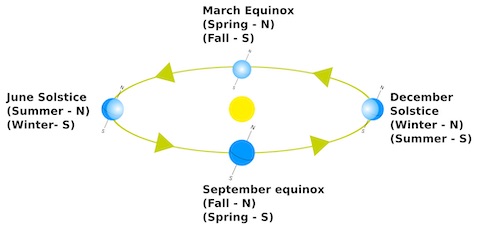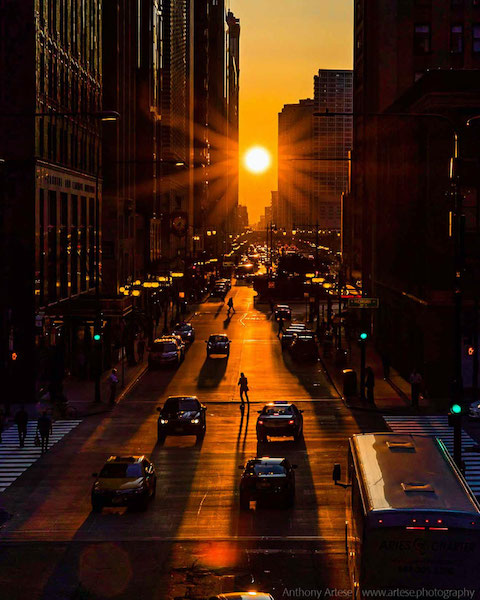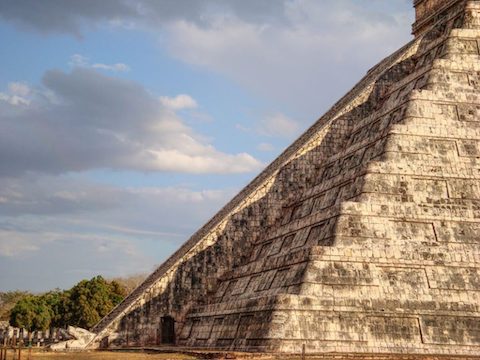
Credit: NOAA
Around September 23rd and March 20th each year, visitors gather at ancient monuments to witness the equinox.
On these two days, day and night are equal everywhere on the planet. The sun rises exactly in the east and sets exactly in the west.
Ancient architects, astronomers, and priests collaborated to align many structures with the equinox sun to create spectacular light effects.
In a 5,000-year-old underground Celtic temple, the rising sun penetrates a long shaft to light an engraved wall.
At a 4,000-year-old Egyptian monument, sunlight travels an east–west hallway to illuminate chosen statues.
A thousand-year-old Mayan pyramid casts a shadow in the form of a snake down its entire face, which joins a giant carved serpent head.
There are equinox sun alignments at Stonehenge, Machu Picchu, Angkor Wat, and many other ancient places, across nearly every culture.
They created these solar light shows to determine and celebrate the autumn equinox—the start of the harvest and shortening days—and the spring equinox—the start of the planting season and a ceremonial time of rebirth.
Religious holidays, like Easter, were set according to the equinox and still are.
You may not have to travel far to see your own equinox sun alignment. In big cities with exact east–west street grids, the equinox sun rises and sets precisely at the ends of a canyon of skyscrapers.
In Chicago, they call it Chicagohenge.
Background
Synopsis: Twice a year, no matter where you are standing on Earth, the amount of daylight and darkness are just about equal. This happens on the day when the sun tracks directly along Earth’s equator and is called an equinox, derived from the Latin for “equal night.”

Credit: Colivine
- Earth orbits the sun on an axis tilted 23.4°, resulting in Earth’s seasons.
- At the solstice, Earth’s Northern or Southern Hemisphere passes through its maximum tilt angle toward the sun, resulting in the longest day of the summer in the hemisphere facing the sun and the shortest day of the winter in the hemisphere facing away from the sun. In a previous EarthDate, we covered the winter solstice.
- At the equinox, Earth is not tilted toward or away from the sun, so light hits the different latitudes evenly. This occurs for an instant in time when the imaginary plane defined by Earth’s equator passes directly through the center of the sun.
- In the Northern Hemisphere, the vernal or spring equinox occurs within a day of March 20th while the autumnal or fall equinox occurs within a day of September 23rd. This is reversed in the Southern Hemisphere.
- The official meteorological shift of the equivalent seasons occurs on March 1 and September 1, earlier than the astronomical shift of seasons on the equinox.

Credit: Anthony Artese
- Through a quirk of physics, refraction of sunlight at dawn and twilight actually bends the the sun’s rays, delivering a bit more than 12 hours of daylight on the equinoxes—depending on your latitude.
- The equator (e.g., Quito, Ecuador) receives 12 hours and 6.5 minutes of equinox daylight.
- At 30 degrees latitude (e.g., Austin, Texas), there are 12 hours and 8 minutes of daylight.
- At 60 degrees latitude (e.g., Helsinki, Finland), there are is 12 hours and 16 minutes of daylight.
- It is possible to witness an exact 12-hour day/night split—called the equilux, from the Latin for “equal light.” Equilux occurs during the shorter days before the spring equinox and after the fall equinox; it takes planning to be aware of the exact dates.
- The line that separates light from dark on the globe passes through both the North and South Poles on the equinoxes.
- During the equinoxes, the sun shines directly onto the noon equator as Earth rotates. Therefore, if you are standing on the equator at noon on the equinox, you won’t cast a shadow.
- Rather than experiencing sunrise and sunset every day, the poles only see one sunrise and one sunset each year—on the spring and fall equinoxes. The spring equinox is the day the sun rises for the first time since the previous fall equinox 6 months ago, and the sun will then stay up giving continuous daylight for the next 6 months. The fall equinox is the day the sun sets and stays below or near the horizon for the next 6 months of darkness.
- On the equinoxes, sunrise is due east and sunset is due west for everyone on the planet.
- In places where street grids are aligned precisely east–west, the sun will rise and set directly along the streets. Chicago and Philadelphia experience these phenomena twice a year.
- The Great Sphinx of Giza faces due east and therefore looks directly into the rising sun on the equinoxes.
- The El Castillo Pyramid at the Mayan ruins of Chichén Itzá was designed to display a dramatic snake of sunlight on the equinoxes. The sunlight appears to slither down the steps until it illuminates a serpent head, thought to represent the snake god, Kukulkán.

Credit: ATSZ56
- The spring, or vernal, equinox signals the start of the planting season, so it was important to agricultural civilizations. This equinox often has connotations of rebirth and is associated with religious holidays.
- Easter is held on the first Sunday after the first full moon on or after the March equinox. If the full moon falls on a Sunday, Easter is delayed a week so it doesn’t fall on Passover.
- The Lakota Tribe in the U.S. Midwest celebrates the start of longer days with a tobacco ceremony.
- Many druids mark the day by watching the sunrise at Stonehenge.
- In the Cantabrian mythology of the pre-Roman Iberian peninsula, tiny fairies called Anjana are said to dance in the forest until dawn, leaving behind roses. Anyone who finds a rose with purple, green, gold or blue petals the next day will have a lifetime of happiness.
- The fall, or autumnal, equinox signals harvest time and the start of the shorter days of winter.

